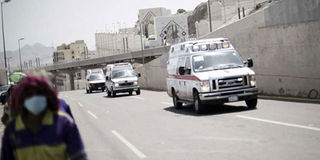Saudis blame pilgrims as 700 die in Hajj

Saudi Arabia ambulances transport injured pilgrims arrive at an emergency hospital in Mina, near the holy city of Mecca, on the first day of Eid al-Adha on September 24, 2015, following a stampede that left at least 700 pilgrims dead and hundreds wounded. Saudi Arabia’s health minister blamed indisciplined pilgrims for the deadly Hajj stampede, in which more than 700 people died. PHOTO | AFP
What you need to know:
- Health Minister Khaled al-Falih said the tragedy would not have occurred if the pilgrims “had followed instructions”.
- Although there are over 4,000 Kenyans taking part in the pilgrimage, none was involved in the tragedy which occurred on Eid-Al-Adha.
- The stampede began in the morning, shortly after the civil defence service said on Twitter it was dealing with a “crowding incident” in Mina, about five kilometres from Mecca.
MINA, SAUDI ARABIA
Saudi Arabia’s health minister Thursday blamed indisciplined pilgrims for Thursday’s deadly Hajj stampede, in which more than 700 people died.
Health Minister Khaled al-Falih said the tragedy would not have occurred if the pilgrims “had followed instructions”.
The head of Central Hajj Committee, Prince Khaled al-Faisal, blamed the stampede on “pilgrims from African nationalities”, according to Saudi-owned al-Arabiya Channel.
Several hundred other pilgrims were also injured in the stampede, one of the worst ever at the annual Muslim pilgrimage.
NO KENYAN CASUALTY
Although there are over 4,000 Kenyans taking part in the pilgrimage, none was involved in the tragedy which occurred on Eid-Al-Adha.
The Supreme Council of Kenya Muslims Secretary-General, Mr Adan Wachu, said that the Kenyans who went for the pilgrimage are expected back in the country next week.
The stampede is the second deadly one to hit the pilgrims this month after a crane collapse in Mecca during the symbolic “stoning of the devil” ritual.
Bodies of pilgrims wearing traditional white were left scattered, surrounded by discarded shoes, flattened water bottles and umbrellas that had been used to shield them from the sun.
The civil defence service said that it was still counting the dead, who included pilgrims from different countries. At least 863 people had also been hurt.
SAFETY ERRORS
Nearly two million people from across the globe were attending the Hajj, one of the largest annual gatherings in the world.
Iran said at least 43 of its citizens had died and accused Saudi Arabia of safety errors that caused the accident.
The stampede began in the morning, shortly after the civil defence service said on Twitter it was dealing with a “crowding incident” in Mina, about five kilometres from Mecca.
Hundreds of thousands of pilgrims had converged on Mina to throw pebbles at one of three walls representing Satan, for the last major ritual of the hajj which officially ends on Sunday.
A hospital official said the stampede happened outside the Jamarat Bridge structure, where the stoning takes place.
A group of pilgrims leaving the area collided with another group that was either moving in the opposite direction or camped outside.
POORLY ORGANISED
A Sudanese pilgrim in Mina said this year’s hajj was the most poorly organised of the four he had attended.
“People were already dehydrated and fainting” before the stampede, said the pilgrim who declined to be named.
People “were tripping all over each other”, he said, adding that a Saudi companion had warned him that “something was going to happen”.
At one hospital, a steady stream of ambulances discharged pilgrims on stretchers.
The incident came as the world’s 1.5 billion Muslims marked Eid al-Adha, the Feast of Sacrifice, the most important holiday on the Islamic calendar.
The Hajj is among the five pillars of Islam, and every capable Muslim must perform it at least once in a lifetime.
PREVIOUS INCIDENCES
For years, the pilgrimage was marred by stampedes and fires, but it had been largely incident-free for nearly a decade following safety improvements.
In the last major tragedy in January 2006, 364 pilgrims were killed in a stampede during the stoning ritual.
In 1990, a stampede in a tunnel at Mina after a ventilation system failure killed 1,426 pilgrims, mainly from Asia.
Thursday’s tragedy occurred outside the five-storey Jamarat Bridge, which was erected in the last decade at a cost of more than $1 billion and intended to improve safety during the pilgrimage.
Almost one kilometre long, it resembles a parking garage and allows 300,000 pilgrims an hour to carry out the ritual. Official figures said 1.95 million pilgrims had performed this year’s Hajj.





